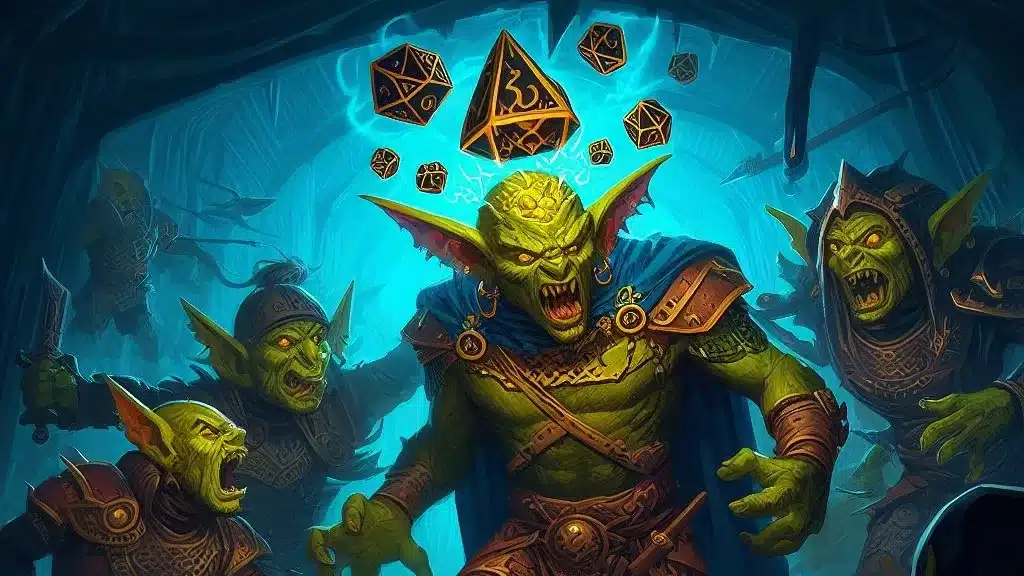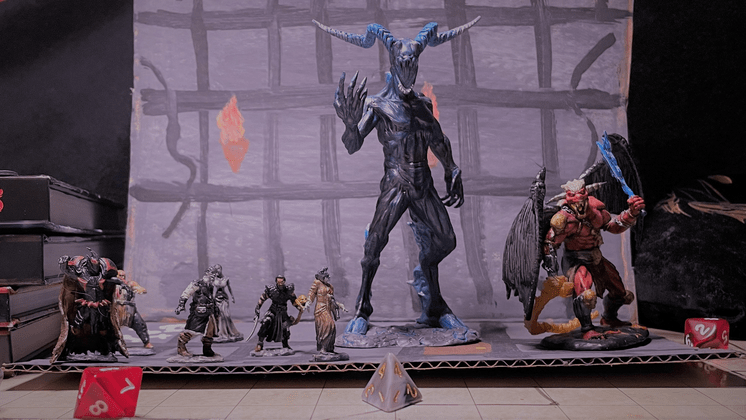You reach into the mind of one creature you can see and force it to make an Intelligence saving throw. A creature automatically succeeds if it is immune to being frightened. On a failed save, the target loses the ability to distinguish friend from foe, regarding all creatures it can see as enemies until the spell ends. Each time the target takes damage, it can repeat the saving throw, ending the effect on itself on a success.
Whenever the affected creature chooses another creature as a target, it must choose the target at random from among the creatures it can see within range of the attack, spell, or other ability it’s using. If an enemy provokes an opportunity attack from the affected creature, the creature must make that attack if it is able to.
Casting Time: 1 action
Range: 120 feet
Components: V, S
Duration: Instantaneous
School: 3rd-level enchantment
Who can cast Enemies Abound? Bards, Sorcerers, Warlocks, and Wizards have Enemies Abound on their class spell lists. No subclasses get Enemies Abound for free.
Xanathar’s Guide to Everything, pg. 155
Enemies Abound 5e
Enemies Abound is one of those spells in DnD 5e that seems like a lot of fun, but fizzles out in actual play. Plus, it’s a nightmare to run as both a DM and a player, since so much is left to the imagination about how it works.
I’ll do my best to parse out the rules of the spell, as well as the best ways to use Enemies Abound in game. I’ll also give some tips for DMs struggling to run the spell in their games, beyond the rules as written.
How Does Enemies Abound Work in 5e?
Enemies Abound forces a creature to make an Intelligence saving throw. If it fails, it regards all creatures it can see as enemies. Whenever an affected creature chooses a target, it must choose randomly among the creatures it can see within the range of the attack, spell, or ability it uses.
If a creature provokes an opportunity attack, the affected creature must make that attack (whether it’s a real enemy or a perceived one).
Each time the affected creature takes damage, it can repeat the Intelligence save, ending the spell early on a success. A creature immune to the frightened condition automatically passes its saving throw.
How to Use Enemies Abound in 5e
Here are a few ways to use Enemies Abound in DnD 5e:
-
Target an enemy surrounded by other enemies. The way Enemies Abound is worded, a creature has to choose a random target in range of their attacks. To take advantage of that, you want there to be more enemies around your target than allies, especially if you’re targeting a melee-only foe. This increases your odds that you’ll actually gain an ally in the fight, rather than potentially still be attacked by them.
-
Target the biggest threat. If you target the heaviest hitter among the group of enemies you’re dealing with, they’ll do more damage to their allies than a weaker enemy would. Even if they flee or do something else with their actions, you’ve still effectively removed the greatest threat to your party.
-
Keep your distance. If you stay far away from the affected creature, you’ll leave them with fewer potential targets for their ranged attacks and spells (if they have them). The more enemies that are in range and the fewer allies that are in range, the more likely it is that they’ll target an enemy.
-
Cause chaos. Enemies Abound isn’t just a spell you can use mid-combat; it can be used in other situations to cause a scene. Like, say you’re trying to sneak past a room in a dungeon that’s filled with baddies. Cast Enemies Abound on one of those baddies, and then scurry past while they fight, a la Lord of the Rings in the Tower of Cirith Ungol.
And if you can stealthily cast it before a fight breaks out, when you and your allies aren’t even on the target’s radar, they’ll only have enemies to choose from when they choose a random target for their attacks.
-
Use the Subtle Spell metamagic. This Sorcerer metamagic removes the verbal and somatic components from a spell. This means, coupled with the above tip, you can effectively start some in-fighting without even having to roll initiative, softening up your adversaries before you engage, or even killing one off completely.
And, as a side tip, if Enemies Abound is used AGAINST your party, you can attack the affected creature with an unarmed attack. Any amount of damage will force a new saving throw, so just deal a small amount of damage if your group’s Rogue is running around slicing up your party. Or, you know, target the spellcaster to break their concentration or kill them.
What Are the Rules for Enemies Abound in 5e?
The rules for Enemies Abound in DnD 5e are as follows:
-
An affected creature doesn’t have to attack anyone. Nothing in the wording of Enemies Abound forces a creature to attack. It merely says that if they attack, they must choose a target for that attack randomly among enemies in range.
Don’t get mad or call meta-gaming cheese if your DM pulls this — it’s perfectly reasonable that a creature, realizing it’s completely outnumbered by enemies, chooses to flee rather than fight. And if they do, that’s still good because you’ve still removed them from the right (and there’s no risk that one of those random attacks will target your allies).
-
An affected creature doesn’t have to move. Again, Enemies Abound’s only stipulation is that when a creature chooses a target, it must choose randomly from enemies in range. If no creatures are in range, it’s under no compulsion to move to a space where a creature is in range. Again, don’t get mad if this is how the creature behaves; it not attacking is still -1 enemy to deal with in the fight.
-
An affected creature can target themselves. The wording of Enemies Abound is that a creature only must choose randomly when it chooses “another creature as a target.” Targeting itself doesn’t trigger this randomness.
Now, I would call BS if a DM did this to self-attack (which is allowed, RAW) in order to deal damage and break the effect early. But on the other hand, choosing to cast Invisibility on yourself or buffing yourself with a defensive spell/ability when you realize you’re severely outnumbered is reasonable behavior.
-
Advantage on saving throws against being frightened doesn’t apply to Enemies Abound. While immunity to the frightened condition causes you to automatically succeed on a saving throw against Enemies Abound, the spell itself doesn’t cause the frightened condition. So, if a creature has a feature like a Halfling’s Brave that gives advantage on saves against being frightened, it doesn’t apply to Enemies Abound, and the save is made as normal.
-
Enemies Abound is eligible for the Twinned Spell metamagic. It only targets one creature, so it can be Twinned. However, this costs 3 sorcery points, so I don’t recommend doing it in almost any scenario.
Is Enemies Abound 5e a Good Spell?
No, Enemies Abound is not a good spell. The main problem? It’s a 3rd-level spell. Sure, it’s a linear upgrade from the similar 2nd-level Crown of Madness, since you don’t have to use your action each turn to get an attack off…but Crown of Madness is terrible.
Sure, Intelligence is the lowest average ability score among DnD 5e’s monsters, so Enemies Abound has a pretty good chance of landing. But it eats up your concentration, and there are just so many better 3rd-level spells to choose from.
Compare it to spells like Hypnotic Pattern, Fear, Fireball, Slow, it’s definitely weak. Even lower-leveled control spells like Tasha’s Hideous Laughter (1st-level, incapacitates the target), Command (1st-level, forces a creature to use their next action on a one-word command of your choice), or Suggestion (2nd-level, 8-hour duration, target follows your reasonable, non-harmful suggestion) are better and/or offer greater utility.
Not to mention that really high-level foes are immune to the frightened condition at a higher rate than lower-level ones, and those are precisely the targets you’d love Enemies Abound to work on the most.
Enemies Abound 5e DM Tips
Enemies Abound is an awkward spell that’s easy to metagame if you’re not careful and deliberate in your rulings. Here are my tips on how to DM the spell:
-
Give the players what they want. Look, Enemies Abound sucks. But if a player really likes the idea of the spell, then let it work the way they think it should. Don’t even choose targets randomly; just attack their enemies, and cause their enemies to turn on them in turn. Even if you run it like that, Enemies Abound is still worse than Hypnotic Pattern, Fear, or Slow.
-
Pick the nearest creatures to choose from for melee attacks. If no enemies are in range, just pick the nearest foes to run to. Even if that’s a PC, it’ll make sense to the players, and they’ll learn to keep their distance from the affected creature.
-
Roll a die for choosing a target randomly. If you don’t like my tip #1 (which is fair, no reason to buff spells if you don’t want to), at least use a die to choose a random target. I recommend making the roll visible to the players so they can see that you’re not metagaming if you do end up attacking them anyway.
-
Roll a die to determine what attack to use. If a creature affected by Enemies Abound has both melee and ranged (or spell) attacks, roll a die to decide which of those attacks you’ll use (unless there are creatures in melee range already; then just attack one of those with a melee attack). Unless you can work in my next tip, which is to…
-
Play the monster’s personality. If that means flee, flee. Not every creature would suddenly see an entire room of enemies and think they should engage in a 1v10. If that means casting area-of-effect spells to take care of everyone in the room at once, do that. But above all, make it clear that you’re not metagaming with these decisions.
These next two tips are for using Enemies Abound against the players:
-
Use it in magical traps. Enemies Abound is hard for players to not metagame with; they don’t want to attack their buddies by accident, after all. But if you have it trigger from a trapped door or something, then they’ll have no one to attack but the other PCs.
-
Have players randomly choose a target AFTER they declare their attack. That way, they can roll a die based on the eligible targets in range of that attack.
Take all these tips with a grain of salt and work with your table. Like I said, it’s an awkward spell, so every table will run it a little differently.


![Flaming Sphere 5e [DnD Spell Guide: Uses, Rules, Tips] find-familiar-5e](https://www.dndlounge.com/wp-content/uploads/2022/03/find-familiar-5e-300x159.jpg)
![Shape Water 5e [DnD Spell Guide: Uses, Rules, Tips] dnd-5e-character-sheet-and-die](https://www.dndlounge.com/wp-content/uploads/2022/03/dnd-5e-character-sheet-and-die-300x157.jpg)
![Spike Growth 5e [DnD Spell Guide: Uses, Rules, Tips] entangle-5e-druid](https://www.dndlounge.com/wp-content/uploads/2022/03/entangle-5e-druid-300x174.jpg)
![Shillelagh 5e [DnD Spell Guide: Uses, Rules, Tips] owlbear-dnd-5e](https://www.dndlounge.com/wp-content/uploads/2022/03/owlbear-dnd-5e-300x218.jpg)